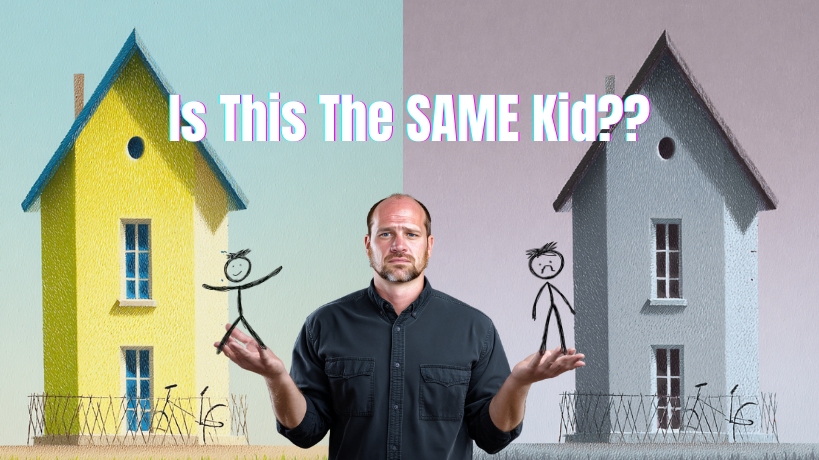You and your coparent have the same child… but you’re raising two different kids.

Navigating Two Worlds: Why Your Child Acts Differently at Each Parent’s House
It’s a frustratingly common scenario for parents who have separated: you get a call from your former partner describing a child you barely recognize. The child you know as quiet and compliant seems to be acting out, pushing boundaries, and arguing about everything at your coparent’s house. Or maybe you’re on the other end of that conversation, wondering why your child seems so different when they’re with their other parent. This can leave you both stuck in a cycle of blame, wondering if one of you is too lenient or too strict. The truth is, you’re both missing a crucial part of the story. You and your coparent may have the same child, but after a separation, you are often raising two different kids.
This difference in behavior isn’t about one parent being “better” than the other. Instead, it’s a powerful psychological force that begins the moment a family separates. Understanding these forces can help you move beyond blaming your coparent or your child and empower you to build a more stable foundation for your family.
Let’s explore three hidden forces that contribute to your child’s two different worlds and then look at practical tools to help bridge them together.
The Emotional Thermostat
Before the separation, your home had one emotional temperature, balanced by two adults. Now, each of you is the sole emotional thermostat for your individual homes. Your house might be calm and predictable because you’re focused on creating stability. Meanwhile, your coparent’s home might be filled with a new kind of energy—maybe they are pursuing new hobbies or dating.
Neither of these situations is inherently right or wrong, but for a child, switching between these two different emotional climates can be exhausting. They are constantly trying to adapt, and this shift in mood is just the beginning.
The Anchor of Attachment
A child’s number one job after a separation is to feel securely attached to both of their parents. They need to know their bond with each of you is strong. At one parent’s house, a child might feel that being perfectly quiet and compliant is the way to maintain that secure attachment. They’re afraid to “rock the boat”.
At the other parent’s house, however, they might feel unconditionally secure. This feeling of security gives them the freedom to release all the anxiety and frustration they’ve been holding in. What you might see as acting out is actually a backhanded compliment—it means your child feels secure enough with you to fall apart completely. If you see this behavior at your coparent’s house, it may not be a sign of leniency; it could be that they are the more secure attachment for your child at that moment. This shift in perspective can be huge for both you and your child.
The Push-Pull Loop
The way your child behaves and how you respond creates a dynamic that can pull your parenting styles farther and farther apart. For example, a child might act out defiantly because they are sad about the separation.
Parent A, who might feel guilty about the separation, responds to this defiance by loosening the rules. The child learns that at Parent A’s house, defiance equals leniency.
The same child then goes to Parent B’s house and acts out in the same way. Parent B doesn’t have the same guilt and responds by putting stricter rules in place. The child learns that at Parent B’s house, defiance equals conflict.
Without ever talking to each other, the two parents have accidentally created two completely different parenting playbooks, leaving the child caught in the middle, trying to figure out how to play by both sets of rules.
Building a Bridge Between Two Worlds
Understanding these forces isn’t about assigning blame; it’s about empowerment. While you don’t have to become a carbon copy of your coparent, you can build a better bridge between your two parenting worlds. Here are three simple tools to help you do just that.
- Find the Low-Hanging Fruit Create some stability by aligning on a few basic rules. Choose three or four simple things like bedtime on a school night, screen time limits, or how homework gets done. Agreeing on these simple things gives your child a predictable foundation they can rely on no matter which home they are in.
- Invite Fun Stories Children often feel a sense of disloyalty when talking about what happens at the other parent’s house. Give your child explicit permission to tell you good things about your coparent. You can start by sharing your own positive memories or things you admire about your coparent. This consistency and positivity will show your child it’s safe to open up and share their own happy moments. Also, make sure they know they can share stories about your household with your coparent. This helps your child see they have one whole life, not two separate lives that can never connect.
- Create a 5-Minute Soft Landing The transfer between homes can be incredibly stressful for a child. For the first five minutes after they arrive, just be calm. Instead of asking a lot of questions, say something like, “I am so happy to see you. Let’s have a snack and just chill for a few minutes”. This gives your child a chance to emotionally decompress from the transition so they can feel ready to be themselves again.
You are not alone in this. Many parents find themselves in a similar situation, but with a little understanding and a few simple strategies, you can begin to build a more connected and stable life for your child.

